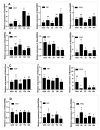Monitoring the Methyl Eugenol Response and Non-Responsiveness Mechanisms in Oriental Fruit Fly Bactrocera dorsalis in China
- PMID: 36354828
- PMCID: PMC9695349
- DOI: 10.3390/insects13111004
Monitoring the Methyl Eugenol Response and Non-Responsiveness Mechanisms in Oriental Fruit Fly Bactrocera dorsalis in China
Abstract
Bactrocera dorsalis is a notorious polyphagous pest in China, and its management strategies largely depend on methyl eugenol (ME), which has been widely used as an attractant to monitor and eradicate B. dorsalis populations for seven decades. However, the non-responsiveness levels in field B. dorsalis populations to ME is unknown. In this study, we monitored the response to ME in field populations from the four most heavily infested provinces in China, and the results showed that the populations had lower sensitivity to ME relative to GZS susceptible strain. The percent responsiveness of the lowest sensitivity population was 5.88-, 3.47-, and 1.47-fold lower relative to the susceptible strain at doses of 1, 10, and 100 µL of ME, respectively. Gene expression analysis and inhibitor assays further revealed that odorant binding protein (BdorOBP2, BdorOBP83b) and the P450 enzyme system may be associated with the lower response to ME. To our knowledge, this work is the first to report that the P450 enzyme system confers a lower responsiveness to lure insects. These findings provided valuable insights for exploiting ME non-responsiveness to protect sterile males from ME-based control strategies and the use of lures combined with insecticides.
Keywords: P450; methyl eugenol; non-responsiveness; odorant binding protein; trapping.
Conflict of interest statement
The authors declare no conflict of interest.
Figures




Similar articles
-
BdorOBP69a is involved in the perception of the phenylpropanoid compound methyl eugenol in oriental fruit fly (Bactrocera dorsalis) males.Insect Biochem Mol Biol. 2022 Aug;147:103801. doi: 10.1016/j.ibmb.2022.103801. Epub 2022 Jun 15. Insect Biochem Mol Biol. 2022. PMID: 35717009
-
BdorOBP2 plays an indispensable role in the perception of methyl eugenol by mature males of Bactrocera dorsalis (Hendel).Sci Rep. 2017 Nov 21;7(1):15894. doi: 10.1038/s41598-017-15893-6. Sci Rep. 2017. PMID: 29162858 Free PMC article.
-
BdorOR88a Modulates the Responsiveness to Methyl Eugenol in Mature Males of Bactrocera dorsalis (Hendel).Front Physiol. 2018 Jul 26;9:987. doi: 10.3389/fphys.2018.00987. eCollection 2018. Front Physiol. 2018. PMID: 30140233 Free PMC article.
-
Comparative sensitivity to methyl eugenol of four putative Bactrocera dorsalis complex sibling species - further evidence that they belong to one and the same species B. dorsalis.Zookeys. 2015 Nov 26;(540):313-21. doi: 10.3897/zookeys.540.6099. eCollection 2015. Zookeys. 2015. PMID: 26798265 Free PMC article.
-
Recent advances in methyl eugenol and cue-lure technologies for fruit fly detection, monitoring, and control in Hawaii.Vitam Horm. 2010;83:575-95. doi: 10.1016/S0083-6729(10)83023-7. Vitam Horm. 2010. PMID: 20831962 Review.
Cited by
-
Antenna-Biased Odorant Receptor PstrOR17 Mediates Attraction of Phyllotreta striolata to (S)-Cis-Verbenol and (-)-Verbenone.Int J Mol Sci. 2024 Apr 15;25(8):4362. doi: 10.3390/ijms25084362. Int J Mol Sci. 2024. PMID: 38673947 Free PMC article.
-
Effect of Schinus areira L. Essential Oil on Attraction, Reproductive Behavior, and Survival of Ceratitis capitata Wiedemann.Plants (Basel). 2025 Mar 4;14(5):794. doi: 10.3390/plants14050794. Plants (Basel). 2025. PMID: 40094735 Free PMC article.
References
-
- Clarke A.R., Armstrong K.F., Carmichael A.E., Milne J.R., Raghu S., Roderick G.K., Yeates D.K. Invasive phytophagous pests arising through a recent tropical evolutionary radiation: The Bactrocera dorsalis complex of fruit flies. Annu. Rev. Entomol. 2005;50:293–319. doi: 10.1146/annurev.ento.50.071803.130428. - DOI - PubMed
-
- Wei D., Liu Y.W., Zhang S.Y., Xu H.Q., Smagghe G., Wang J.J. A male accessory gland specific gene takeout2 regulates male mating success in Bactrocera dorsalis. Entomol. Gen. 2021;41:579–589. doi: 10.1127/entomologia/2021/1094. - DOI
-
- Zeng Y., Reddy G.V.P., Li Z., Qin Y., Wang Y., Pan X., Jiang F., Gao F., Zhao Z.-H. Global distribution and invasion pattern of oriental fruit fly, Bactrocera dorsalis (Diptera: Tephritidae) J. Appl. Entomol. 2019;143:165–176. doi: 10.1111/jen.12582. - DOI
-
- Liu H., Zhang D.j., Xu Y., Wang L., Cheng D., Qi Y., Zeng L., Lu Y. Invasion, expansion, and control of Bactrocera dorsalis (Hendel) in China. J. Integr. Agric. 2019;18:771–787. doi: 10.1016/S2095-3119(18)62015-5. - DOI
-
- Zhu Y.-F., Tan X.-M., Qi F.-J., Teng Z.-W., Fan Y.-J., Shang M.-Q., Lu Z.-Z., Wan F.-H., Zhou H.-X. The host shift of Bactrocera dorsalis: Early warning of the risk of damage to the fruit industry in northern China. Entomol. Gen. 2022;42:691–699. doi: 10.1127/entomologia/2022/1453. - DOI
Grants and funding
- 32102250/National Natural Science Foundation of China
- ZR2021QC017/Natural Science Foundation of Shandong Province, China
- 663/1121018/Scientific Research Fund for High-level Talents in Qingdao Agricultural University
- 2019JZZY010711/Major Scientific and Technological Innovation Projects in Shandong Province
LinkOut - more resources
Full Text Sources

